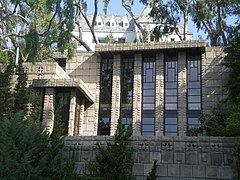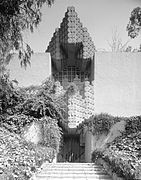Concrete block
Concrete blocks are decorative elements made from concrete.
United States
In the United States , Frank Lloyd Wright had used so-called textile blocks as early as the 1920s: Hollyhock House (1922), Millard House (1923), John Storer House (1923), Ennis House (1924) and Samuel Freeman House (1924). All five houses are built in the so-called Mayan Revival style. Wright's son Lloyd built the John Sowden House in the same style in 1926, also using textile blocks . All of the above examples are in the Greater Los Angeles area .
Europe

Since the late 1960s, molded concrete blocks were used primarily in the GDR, but also in other parts of Europe, especially in Eastern Europe. They were and are still used today to demarcate properties or to decorate wall areas. Characteristic for this was the opening optics with convex or concave contouring, which produced a change of shade depending on the position of the sun.
Hubert Schiefelbein was a well-known designer of molded concrete blocks .
Individual evidence
- ^ Frank Lloyd Wright's Textile Houses. Retrieved June 22, 2020 .
- ^ The Sowden House. Retrieved June 22, 2020 .
- ↑ detail. December 5, 2019, accessed January 25, 2020 .
- ^ Symposium on Art in Architecture in the GDR - "There is a whole new perception of GDR architecture". Retrieved January 25, 2020 (German).
- ↑ Jochen Schmidt: Concrete blocks. November 27, 2015, accessed January 25, 2020 .
- ↑ Concrete structures | Dirk Schermer. Retrieved January 25, 2020 (German).





